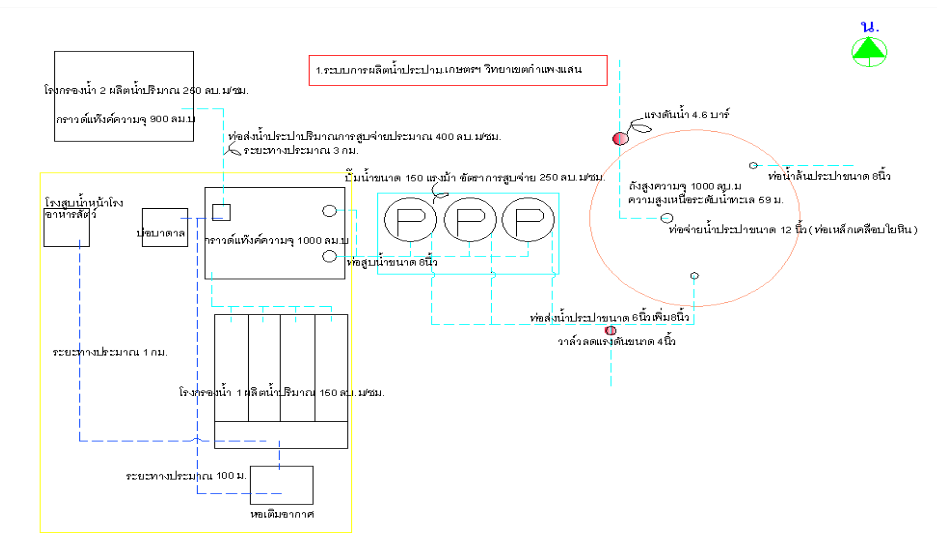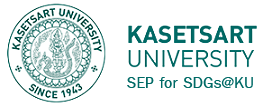Water management is an important factor for the University. Therefore, the University has a policy to promote and support students and staff to aware of conservation of energy by set campaign, project and activity on energy conservation. In addition, put more effort on operation of underground water storage ponds, wastewater treatment, and water recycling. Moreover, using of energy saving electrical appliances so that students and staff will change behavior of energy consumption and reduce the use of the wrong equipment which waste energy.
4.1-1 Kasetsart University has appointed of the Board of Directors for Energy Management, to deciding the Policy Formulation, Implementation Plan and the University’s energy conservation guidelines (Figure 4.1-1)

(Figure 4.1-1 Appointment of Energy Management Committee)
4.1-2 Kasetsart University has the policy to organize activities or projects to conserve energy, water using in the workplace, public relations within department and through the website (Figure 4.1-2)
.
Public relations through the website of Kamphaeng Saen Campus
(Figure 4.1-2 Public Relations in Organizations)
4.1-3 Energy-saving campaign / Sports Personnel Program for health (Figure 4.1-3)

(Figure 4.1-3 Energy saving campaign / Sports Personnel Program for health)
4.1-4 Water-saving campaign and toilet paper reduction program (Figure 4.1-4)

(Figure 4.1-4 Water-saving campaign and toilet paper reduction program)
4.1-5 To reduce using water in toilet by filling water in 2 bottles water, placing the water bottles in the water tank at the back of the toilet. This method is not to obstruct the entrance of the water. Then close the rear tank lid. Try Pressing the toilet flush as usual. The water can be saved about 3 litres per each. (Figure 4.1-5)

(Figure 4.1-5 Reduce water use from toilet)
4.1-6 Water Management Project by controlling weed around the surrounding areas which helps tobalance the water conservation and doesn’t cause sewage in the canal and wastewater treatment. (Figure 4.1-6)

(Figure 4.1-6 control weed around the surrounding areas)
4.1-7 Enzyme Ionic Plasma Policy for Wastewater Treatment within Kasetsart University (Figure 4.1-7)

(Figure 4.1-7 Enzyme Ionic Plasma Policy for Wastewater Treatment)
4.1-8 Water Management Project can solve drainage clogs, clean up pipes / canals, and improve a drainage system for flood management (Figure 4.1-8)

(Figure 4.1-8 Water Management Project to solve drainage clogs, clean up pipes / canals)
4.1-9 To check the 150-horsepower pump system for life long service and to prevent repairiug frequently. All pumps should have the records of the maintenance in using and timetables for a punctual monitoring and maintenance. (Figure 4.1-9)

(Figure 4.1-9 Checking the pump system.)
4.1-10 Collection of rainwater
Precipitation reservoir for sterilization. Water-saving campaigns has been developed in using water saving tap (see Figure 4.1-10)

(Figure 4.1-10 rain water reservoirs)
Collection of rainwater for watering vegetables in buildings ( Office of the Library) (Figure 4.1-10)

(Figure 4.1-10 Rainwater Collection)
4.1-11 Underground water storage tanks
Ngamwongwan parking lot 2 is equipped with underground water storage tanks in order to prevent potential land subsidence with the space saving and stable water temperature. (Figure 4.1-11)

(Figure 4.1-11 Underground water storage tanks)
4.1-12 Building ponds / lakes for keeping water
Kasetsart University Kamphaengsaen Campus builds the 7 wells of ponds and lakes for keeping water to use. Wells in the area are approximately 416 rai. One well in 130 rai can produce for tap water of 48,000 cubic meters / year. (Figure 4.1-12)

Well No. 1 in 150 rai can produce tap water of 48,000 cubic meters / year.

Well No. 2 in 50 rai Well No. 3 in 80 rai

Well No. 4 in 80 rai Well No. 5 in 80 rai

Well No. 6 in 70 rai Well No. 7 in 40 rai
(Figure 4.1-12 Water storage at Kamphaeng Saen Campus)
Kasetsart University Chalermphrakiat Sakon Nakhon Province Campus has 7 water reservoirs including Kalasin Reservoir, Nakhon Phanom Reservoir, Mukdahan Reservoir, Sakon Nakhon Reservoir, Nong Khai Reservoir and Udon Thani Reservoir. Total 1,400,000 cubic meters of water are collected from each reservoir for using in agricultural research areas (Figure 4.1-13).

(Picture 4.1-13 of the rain reservoir at Kasetsart University Chalermphrakiat Sakon Nakhon Province Campus)
4.2-1 Recycling Waste Water from ponds, natural ponds for lawns and trees.
To install water pumps by using sprinklers within the wastewater treatment ponds for watering the lawn.
To use water from natural ponds, for watering trees to replace tap water (Figure 4.2-1)

(Figure 4.2-1 installing the water pump using sprinklers)

(Figure 4.2-1 Usin water from natural ponds and watering trees to replace tap water)
4.2-2 using of treated water in flushing toilets
To recycle Water of KU Dairy Center using for cleaning floors and flushing toilets.
.
Reverse Osmosis Soft
drink production of Kasetsart University with Filters and Reverse Osmosis Systems

1.Water is flowed through the sand, carbon

2.Then run into Reverse Osmosis and resin strainers.

3. It cannot produce drinking water flows into the tube and then separates from the tank.

4. The water flows in the pipe to the first floor of the building.

5. Then, flow in the pipe which is connected to the tank on the first floor.

6. The water is kept in the pump for daily use.

7 .The recycled water is used for cleaning up the floor. 8. Using recycled water in flushing the toilets.
(Figure 4.2-2 Using recycled water in flushing the toilets)
4.2-3 using recycled water to the car wash.
Water treatment plants

Water tank refill the treatment pond to recycle water

Using recycled water from the wastewater treatment plant to wash vehicles

(Figure 4.2-3 using recycled water to wash vehicles)
4.2-4 Water Recycling System in Tilapia Hatchery
Water Recycling System in Tilapia Hatchery. The water is used to hatch the fish that is supplied with flowing water all the time. The water from the hatching tubes will flow into the support tray before flowing into the PVC pipe and circulating through the hose to return to the top of the hatching tubes. With this system of rotation can reduce the amount of water needed each day. The amount of water need to be added each day is about 2% of the total system water is about 20 liters.

Water Flow direction
(Figure 4.2-4 Water Recycling System in Tilapia Hatchery)
Kasetsart University uses electrical equipment efficiently, can reduce water consumption more than 75%.
Kasetsart University has been using the electrical equipment efficiently which can reduce water consumption more than 75 percent
4.3-1 Introduction of sanitary wares can save a lot of water based on the principle of using water instead of old water to purify. This way use less water and wash quickly. The push button is located on the top of the water tank with two buttons, which can save up to 3 liters of water (Figure 4.3-1)
.
(Figure 4.3-1 Water-saving System)
4.3-2 Introduction of automatic stop system for wash basins and toilet stalls for men by pressing the button when it is used. The water flow will stop automatically (Figure 4.3-2)
.
.
(Figure 4.3-2 Automatic Stop Flow)
4.3-3 The sensor system can detect the on / off motion of the lights and the fans automatically (Figure 4.3-3)
.
(Figure 4.3-3 Motion Sensor System)
4.3-4 Sink sensor system, water will flow and stop automatically as soon as when the hands pull in/cut. (Figure 4.3-4)
.
(Figure 4.3-4 Sink sensor system)
4.3-5 The sensor system of the men’s sanitary ware will run the water when standing, if the user leaves stands, the water will stop flowing immediately. (Figure 4.3-5)
.
(Figure 4.3-5 Sink sensor system)
Kasetsart University Bangkhen and Sriracha Campus do not produce water supply.
Kasetsart University Kamphaeng Saen and Chalermphrakiat Sakon Nakhon Province Campus produce own water supply
Water consumption of each campus

(Table 4.4-1 Water consumption)
Water Supply Process, Kasetsart University

(Figure 4.4-1 Water Supply Process)
Water and Wastewater Measurement

The result of the water that was measured before released outside Kamphaeng Saen Campus.

(Figure 4.4-2 Water and Wastewater Quality Report)
